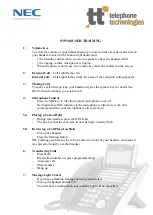
Operation And
Maintenance
I. Important Water Quality Assurance
Requirements
Reverse Osmosis drinking water appliances contain
treatment components that are critical for effective
reduction of Total Dissolved Solids as well as inor-
ganic chemical contaminants. Water Factory
Systems strongly recommends that the user test the
water periodically (every six months minimum) to
verify that the system is performing satisfactorily.
Some models have a Percent Rejection (PR) Water
Quality Monitor to provide the user with a means to
test the water at any time. If a PR Monitor is not
used, your dealer may offer a bi-annual water test-
ing service. Routine maintenance is necessary in
the form of prefilter, postfilter, and membrane
replacement, based on the following guidelines:
A)
Sediment Prefilter, Carbon Prefilter, or
Sediment/Carbon Prefilter, optional Prolonged
Contact Filter (PCF Models), and Carbon
Postfilters - Change every six months to one year
depending on feedwater quality.
B)
Membrane - Change as required based on:
• Built in Percent Rejection Water Quality Monitor
(PR Models only).
• A bi-annual testing service may be offered from
your dealer if a monitor is not used.
NOTE:
Recommended maximum membrane
service life is 36 months.
II. Replacing Filter Cartridges
The life of prefilter cartridges generally depends on
local water conditions (i.e., dirt, rust and/or chlorine
levels) while the life of post filters is generally deter-
mined by the length of service.
When To Replace Sediment Prefilter
A)
Every six months to one year. Check cartridge
after six months. If discoloration is observed on
inside core or a layer of sediment is deposited on
the outside surface, then the cartridge should be
replaced. Otherwise, replace cartridge yearly.
B
) As a rule, private wells require more frequent
sediment prefilter changes while softened feed
water usually requires only yearly replacement.
C)
Recommended maximum sediment prefilter service
life is one year.
When To Replace Carbon Prefilter
(4500 and 5000 Series Only)
The carbon prefilter removes free chlorine from the
feedwater supply to protect the TFCM membrane from
chlorine attack. To find out the chlorine level in a
water supply, the water should be tested for free chlo-
rine or call the public water supplier.
A)
With free chlorine levels up to 1mg/L, the carbon
prefilter should be changed every year.
B)
With free chlorine levels exceeding 1 mg/L, the car-
bon prefilter should be changed every six months.
When To Replace Carbon Postfilter
A)
If the filter is being used to control tastes and
odors, replace every year.
B)
If the filter is being used to meet standards for chlo
ramines, change every six months.
C)
If the filter is being used to meet standards for a
regulated organic chemical contaminant, then
replacement should be based on a monitoring
program established with a public health agency.
How To Replace Prefilter And Postfilter Cartridges
Replacement of filter cartridges generally requires:
• New replacement cartridges
• Water Factory filter wrench or equivalent
• Replacement O-rings for filter housing(s)
• Cleaning brush (optional)
• Sanitizing supplies (See Section IV)
• Cloth or sponge to clean up any spillage
• Removal of the purification assembly from its location
A)
Open faucet to drain tank and turn off feed water.
Wait five minutes for purification assembly to
depressurize.
B)
Using filter wrench, unscrew the filter bowl, coun-
terclockwise viewed from the bottom.
C)
Discard water in bowl and the used filter car
tridge. Set O-ring(s) aside.
D)
Scrub inside filter bowl with a brush using hot
water and a mild detergent. Rinse thoroughly.
E)
Insert new filter replacement cartridge and follow
instructions for sanitizing the purification assem-
bly. Replace O-ring(s) if necessary. Note: O-
rings should be lubricated before putting into
service using a food grade silicone lubricant or glycerin.
F)
Attach filter bowls to proper purification assembly
head(s).
13

































